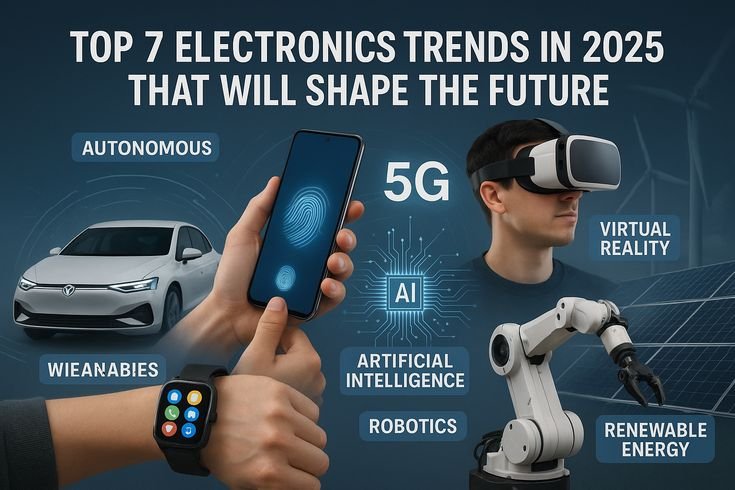Technology is evolving at an unprecedented pace, and in 2025, we are seeing transformative trends that are not just changing industries but also the way we live. From AI to quantum computing, the future promises groundbreaking advancements that will redefine productivity, security, and connectivity. In this article, we explore the top seven technology trends in 2025 that will shape the future, offering insights into how these innovations will impact businesses, individuals, and society as a whole.
1. Artificial Intelligence (AI) and Advanced Machine Learning
Artificial intelligence continues to dominate the tech landscape, with 2025 marking a significant leap in AI capabilities. Machine learning models are becoming more sophisticated, enabling smarter automation and deeper insights across industries.
Key Developments:
-
Generative AI: Tools like ChatGPT and DALL·E are evolving to create more advanced content, including images, music, and video. In 2025, generative AI will be used in marketing, entertainment, and content creation on an even larger scale.
-
AI in Healthcare: AI’s role in healthcare is expanding, from diagnostics to personalized medicine. In 2025, AI-driven algorithms are expected to significantly improve disease prediction, treatment recommendations, and drug development.
-
Autonomous Systems: From self-driving cars to automated factories, AI-powered systems are becoming increasingly reliable, contributing to more efficient and autonomous operations.
Why It’s Important:
-
Increased Efficiency: AI and machine learning improve operational efficiency, automate repetitive tasks, and enhance decision-making across sectors like healthcare, finance, and manufacturing.
-
Personalization: These technologies allow for deeper personalization in everything from customer service to healthcare, making products and services more relevant to individual needs.
2. Quantum Computing: The Next Frontier in Computing Power
Quantum computing, which leverages the principles of quantum mechanics to solve complex problems at unprecedented speeds, is expected to become more accessible in 2025. This technology will dramatically impact industries like cryptography, drug development, and material science.
Key Developments:
-
Cryptography: Quantum computing will revolutionize encryption methods, creating stronger security protocols that can withstand current hacking techniques.
-
Drug Discovery: Quantum computers can model molecular structures far more efficiently than classical computers, drastically speeding up drug development and enabling breakthroughs in treatments for complex diseases.
-
Optimization: Industries like logistics and finance are set to benefit from quantum computing’s ability to solve complex optimization problems, such as improving supply chain management and financial forecasting.
Why It’s Important:
-
Unprecedented Speed: Quantum computing will solve problems that are currently too complex for traditional computers, enabling breakthroughs in science, medicine, and technology.
-
Security: Quantum-enhanced encryption will make digital data more secure, a necessity as cyber threats continue to grow.
3. 5G Connectivity and Beyond: Ultra-Fast, Low-Latency Networks
The global rollout of 5G networks continues in 2025, offering faster speeds and lower latency than ever before. As 5G becomes the standard, it will enable new capabilities in IoT, autonomous vehicles, and smart cities.
Key Developments:
-
Faster Speeds: 5G can offer speeds up to 100 times faster than 4G, enabling seamless streaming, rapid data transfers, and low-latency communication in real-time.
-
IoT Expansion: 5G networks are set to power the next wave of Internet of Things (IoT) devices, from smart homes to industrial automation. The ability to connect billions of devices simultaneously will revolutionize sectors such as healthcare, agriculture, and logistics.
-
Autonomous Vehicles: 5G’s ultra-low latency will enable the real-time communication required for autonomous vehicles to operate safely on public roads.
Why It’s Important:
-
Enhanced Communication: 5G will transform the way we communicate, making video calls, streaming, and real-time collaboration faster and more reliable.
-
Smart Infrastructure: 5G is the backbone of smart cities, supporting connected infrastructure, autonomous vehicles, and data-driven services to improve urban living.
4. Blockchain and Decentralized Finance (DeFi)
Blockchain technology is transforming the financial sector, offering decentralized alternatives to traditional banking systems. In 2025, blockchain’s use will extend beyond cryptocurrencies, providing innovative solutions for secure, transparent transactions across multiple industries.
Key Developments:
-
Smart Contracts: These self-executing contracts on the blockchain will streamline processes in industries such as real estate, insurance, and law, reducing the need for intermediaries and speeding up transactions.
-
Decentralized Finance (DeFi): DeFi platforms will continue to disrupt traditional banking by allowing peer-to-peer lending, borrowing, and trading of assets, offering more financial freedom and lower fees.
-
NFTs and Digital Ownership: Non-fungible tokens (NFTs) are evolving, expanding beyond art and collectibles into sectors like gaming, fashion, and intellectual property.
Why It’s Important:
-
Financial Inclusion: DeFi and blockchain enable access to financial services for individuals who may not have access to traditional banking systems, fostering greater inclusivity.
-
Trust and Transparency: Blockchain’s decentralized and transparent nature ensures trust in digital transactions, enhancing security and reducing fraud.
5. Augmented Reality (AR) and Virtual Reality (VR): Immersive Digital Experiences
AR and VR technologies are rapidly advancing in 2025, creating immersive and interactive experiences that are transforming industries such as entertainment, education, and retail.
Key Developments:
-
Retail and E-Commerce: AR is revolutionizing online shopping by allowing customers to try on clothes virtually or visualize how furniture will look in their homes. VR, on the other hand, is offering virtual store tours and immersive shopping experiences.
-
Gaming and Entertainment: VR is making gaming more immersive, allowing players to step into entirely new worlds. Live events, such as concerts and sports games, are also being enhanced through VR and AR technologies.
-
Education and Training: Both AR and VR are transforming education by offering immersive learning experiences. VR simulations provide hands-on training, while AR enhances traditional learning with interactive visual aids.
Why It’s Important:
-
Enhanced Interaction: AR and VR provide highly engaging, interactive experiences that are more memorable and effective than traditional media.
-
New Opportunities for Business: These technologies open up new avenues for customer engagement, training, and marketing, creating unique, personalized experiences.
6. Edge Computing: Real-Time Data Processing
Edge computing is becoming increasingly important in 2025, particularly in the context of IoT and real-time data processing. This technology involves processing data closer to where it’s generated, reducing latency and bandwidth usage.
Key Developments:
-
IoT Optimization: As the number of connected devices grows, edge computing enables faster processing of data from IoT devices, improving efficiency in applications like smart cities and autonomous vehicles.
-
Industrial Automation: In manufacturing, edge computing allows for real-time data analysis, enabling predictive maintenance and optimizing production workflows.
-
Healthcare: In healthcare, edge computing is used to analyze patient data in real-time, allowing for quicker responses to medical emergencies and improving patient care.
Why It’s Important:
-
Faster Decision Making: By processing data locally, edge computing enables faster, more informed decision-making in critical applications, such as autonomous driving or healthcare.
-
Reduced Latency: Edge computing reduces the need to send large amounts of data to centralized data centers, ensuring smoother performance and quicker results.
7. Robotics and Automation: Transforming Industries
Robotics and automation technologies are increasingly being integrated into everyday life, from manufacturing to healthcare, making tasks more efficient and cost-effective.
Key Developments:
-
Autonomous Delivery: Robotics is streamlining logistics and supply chains, with autonomous drones and vehicles delivering goods directly to consumers, reducing delivery times and costs.
-
Healthcare Robotics: Robots are being used for surgeries, rehabilitation, and patient care, providing greater precision and allowing healthcare professionals to focus on more critical tasks.
-
Smart Manufacturing: In industrial settings, robots are working alongside humans to automate repetitive tasks, improving efficiency and safety on the factory floor.
Why It’s Important:
-
Enhanced Productivity: Automation and robotics increase efficiency, reduce human error, and lower operational costs in industries like manufacturing, logistics, and healthcare.
-
Improved Accessibility: Robots can assist in tasks that are difficult for humans, such as performing surgeries or helping elderly individuals with mobility challenges.
Conclusion: Embracing the Future of Technology
The tech trends emerging in 2025 are transforming every aspect of our lives, from the way we communicate and work to how we shop, learn, and receive healthcare. As AI, 5G, blockchain, AR/VR, edge computing, and robotics evolve, they are creating a more connected, efficient, and immersive world. These innovations not only promise to improve existing processes but also offer new opportunities for growth, efficiency, and personalization across industries. Embracing these technologies will be key to staying competitive in an increasingly digital future.

